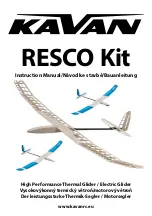
11
You should use a harness that has an ABS cross strap system and the maximum width
possible for the chest strap is 38 cm between karabiners.
For you own safety, we strongly recommend the use of back protection, helmet and
Windtech
WindSOS
reserve.
-- inflation and take off
A paramotor launch is always more complicated than a free-flying (without paramotor)
one. More weight, the thrusting force of the wing, different position of the risers, accel-
erator throttle in one’s hand, etc, makes this usually the most difficult part of a paramo-
toring flight.
One has to bear in mind that a failed launch could result in the lines getting caught in
the propeller, breaking not only the lines but also the propeller itself, and in the worst
case could result in injuring oneself, or a bystander. For this reason it is very important
that you should not launch your paramotor in the vicinity of other people, and you
should always make sure that no one is near enough to sustain any injury from your
launch attempt. This could be either directly, for example from you colliding into them,
or indirectly, from flying debris blown up from the ground behind you from the thrust of
the engine, or from flying debris from a damaged propeller.
The pilot needs to always be very thorough and methodical with carefully preparing their
equipment and doing all of the required pre-flight checks, using a clear and complete
checklist. Always allow ample security margins to make room for any error, especially
during take-off and landing, and never forget that flying with a propeller that is rotat-
ing 40cm from your body carries inherent risks of serious injury and is therefore NEVER
a game!
For a good launch with the
EVO
always remember AT LEAST the following:
-in no wind conditions we recommend to release 2 cm of trim, therefore you will get a
better inflation in the way up of the canopy.the canopy.
Lay out the glider as perpendicular to the wind as possible, for a better inflation.
Lay the glider out in an arc, which will help the wing inflate in the centre first and come
up straight and uniformly. If there is some wind, a pre-inflation, to get some air in the
glider and clear the lines, will increase the chances of a successful launch.
Make sure that the risers are not twisted and everything is set up correctly.
Carefully check all of the lines and attachments points, to make sure there are no twists,
knots, or tangles, and that everything is correct and free running.
Carefully check that the maillons, the big-ear cleats, and the trim are secure, correctly
set and free running. Make sure that the big-ears facility is fully open (fully un-cleated),
so that the ears are not pulled in on launch.
Make sure that the trimmers are on the “normal” position for take off (first line of stitch-
Summary of Contents for EVO 23
Page 1: ...E V O m a n u a l...
Page 2: ......
Page 3: ...3 Windtech w w w w i n d t e c h e s E V O 2 3 2 5 2 7 3 0 flight manual...
Page 20: ...20...
Page 27: ......










































